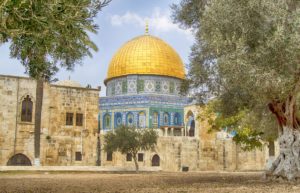Here are the enemies of Allah in the House of Allah clinging to the walls of the Ka’abah of Allah making a compact to fight a war against His Rasul – and then return satisfied with a new passion for war! This is unique manifestation of the forbearance and magnanimity of Allah Ta’ ala. Then, the ultimate end of this compact is not too far to find. It will appear towards the end of the narrative in that all of them bolted from this battle.
These Jews, after having made a pact with the Quraish of Makkah, reached the tribe of Ghitfan, a great warring tribe of Arabia. They told them that they and the Quraish of Makkah were in full agreement with the plan to eliminate the spreaders of this new religion (Islam) once for all with their combined power. They asked them too to join hands with them in that pact. Then, they also offered them a bribe. They promised to give them the total produce of dates in one year in Khaibar – according to some narrations, they promised the half of it to the tribe of Ghitfan. ` Uyaiynah Ibn Hisn, the chief of the tribe of Ghitfan, approved of his participation in the pact under this condition. Thus, they too became a part of the war effort.
Then, in accordance with the mutual pact, the Quraish armed force of four thousand men, three hundred horses and war supplies laden on one thousand camels came out of Makkah under the command of Abu Sufyan and stopped at Marr az-Zahran. Here, all tribes of Aslam, Ashja’, Banu Murrah, Banu Kinanah, Fazarah and Ghitfan joined them. Their total number has been reported in some narrations as ten thousand, as twelve thousand in some others and as fifteen thousand in still other.
When the information about this aggressive united front reached the Holy Prophet (SAW), the very first verbal reaction came out from him in the words: Allah is all-sufficient for us, and the best One to trust in – 3:173. After that, he assembled opinion leaders from among the Emigrants and Helpers together and went into consultation with them. Although, the blessed recipient of Wahy (revelation) really needs no consultation for he acts directly with the permission of Allah Ta’ ala. But, there were two advantages in having such consultation: (1) To initiate and establish the Sunnah (practice) of consultation in the Muslim community and (2) to revive mutual liaison and unity in the hearts of the believers and to persuade them to the need of helping and supporting each other. After that, they talked about matters of defence and the physical resources needed in fighting a war. Present among the group of consultants. there was Sayyidna Salman al-Farisi ؓ who had recently freed himself from the artificially imposed slavery of a Jew and had devoted himself to the service of Islam. He advised that in his country, the Persian kings have used trenches they arranged to be dug across the enemy line of attack. This had always helped stop the enemy. Accepting his advice, the Holy Prophet ﷺ ordered that trenches be dug – and he himself participated with others doing that.
It was decided to dig this trench on the entire passage way behind the mount of Sal’ which could be used by the enemy to come into Madinah from the north. The ground marking of the length and width of this trench was personally drawn by the Holy Prophet (SAW). Beginning from Shaikhayn, this trench came as far as the western corner of the mount of Sal’ and later it was extended to the intersection of the valleys of Buthan and Rana. The total length of this trench was approximately three and a half miles. The precise measurement of the width and depth could not be ascertained from any narration. But, it is obvious that the width and depth would have also been special, of the kind the enemy would have not found easy to cross.
By chance, in the section of the trench entrusted with Sayyidna Salman and others with him, a huge, hard and glossy rock showed up. Sayyidna Salman’s colleague, Sayyidna ` Amr Ibn ` Awf ؓ says, “This rock broke our implements and we failed to cut it apart. Then I suggested to Salman that though it is possible to dig the trench bypassing the huge rock and join it up with the main trench with a minor crookedness in it, but we should not deviate from the line drawn by the Holy Prophet ﷺ as based on our opinion. So, you go, tell the Holy Prophet t about the position here and get an order from him about what we should do now.”
